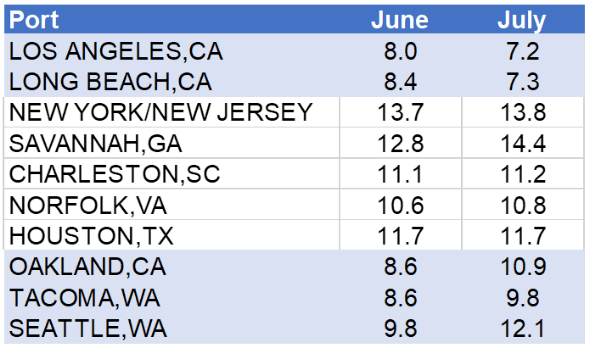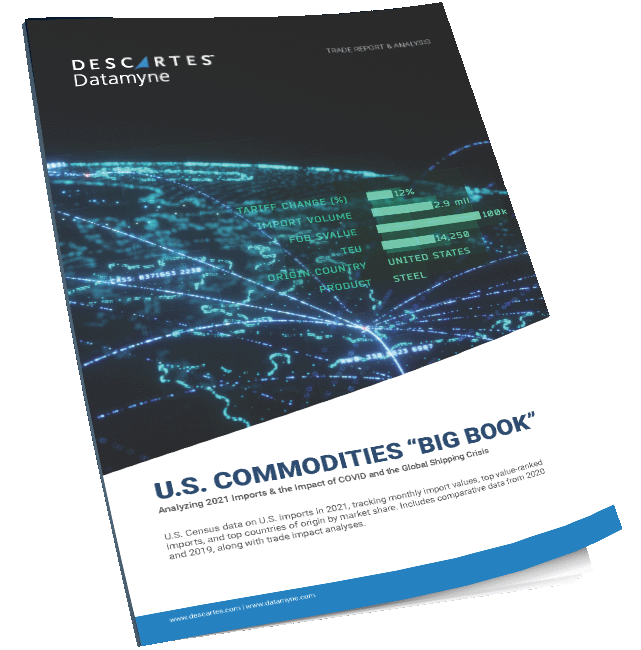The Global Shipping Crisis
July U.S. Container Import Volume Maintains Record Trend for 2022 as Port Congestion and Delays Persist
U.S. container import volumes in July 2022 set yet another record versus July 2021. While lower than the all-time record in May 2022, volumes remain above the level that has caused port congestion and delays for the last 17 months. A number of factors, such as a slowing economy, inflation and high fuel costs have not had the anticipated impact on slowing down U.S. container imports. The combination of increased import volumes from China, delays at major East and Gulf Coast ports and the high number of ships waiting off those ports continues to put pressure on supply chain predictability. The August update of the logistics metrics Descartes is tracking continues to point to congested and challenging global supply chain performance for the rest of 2022.
In this Article...
- July continued the record monthly trend for U.S. container import volume.
- West Coast ports continue to lose ground to East and Gulf Coast ports while small ports see a turnaround in July.
- July port delays worsen at major East and Gulf Coast ports.
- Managing supply chain risk: what to watch in the second half of 2022.
- Consider recommendations to help mitigate pressure of ongoing global shipping crisis.
July continued the record monthly trend for U.S. container import volume.
Container imports into the U.S. set another monthly record (see Figure 1), as TEU volume was up 3% from July 2021 to 2,530,906 and up 15% from pre-pandemic July 2019. Every month in 2022 has been a record month when compared to previous years. In July, container import volume reversed its June decline and was up 2% versus July 2022.
Figure 1: U.S. Container Import Volume Year-over-Year Comparison

Source: Descartes Datamyne™
In July, U.S. container import volumes from China were up 6.9% to 994,927 TEUs compared to June 2022 and up 6.3% versus July 2021. Chinese imports in July were the highest of 2022, eclipsing pre-lock down January 2022. At 64,081 TEUs more in July 2022, China was a big contributor to the increased U.S. container import volume, representing 75% of the increase from the top exporters to the U.S. Chinese manufacturing and ports appear to be fully back online.
West Coast ports continue to lose ground to East and Gulf Coast ports while small ports see a turnaround in July.
East and Gulf Coast ports continued to lead the West Coast ports in volume in July 2022 versus June 2022, and the increase has benefited smaller ports more. Comparing the top five West Coast ports to the top five East and Gulf Coast ports in July 2022 versus June 2022 shows that, of the total import container volume, the East stayed flat in July 2022 at 44.4%, while the West declined to 40.6% in July 2022 from 42.35% in June 2022. The top 10 ports lost share in July 2022 to smaller ports as the top 10 represented 85.1% of all volume, compared with 86.7%% in June 2022 and 87.5% year-on-year.
Looking at five-month periods (see Figure 2), top West Coast ports (orange), with the exception of Long Beach and Seattle, experienced container throughput shifts to other ports, including on the East and Gulf Coasts (blue). The Port of Los Angeles retook the top spot at 468,071 TEUs in July 2022, up ~24,000 TEUs compared with June 2022. New York/New Jersey came in second and flat versus June 2022 and Long Beach third, but it again dropped considerably in July by ~24,000 TEUs.
Figure 2: Container Import Volume Shifts at Top 10 Ports

Source: Descartes Datamyne
Part of the shift to East Coast ports can be attributed to the growth of Chinese imports and shippers’ decisions based upon last year’s West Coast port congestion. Of the increase in Chinese imports in July 2022, the Ports of Savanah, Houston and Charleston saw 24.8%, 20.3% and 19.0% growth, respectively. The only West Coast port that saw a similar increase was Seattle at 25.9%. Long Beach saw the greatest decline at -7.3%.
July port delays worsen at major East and Gulf Coast ports.
July 2022 showed reduced delays at the two largest West Coast ports, but rising wait times at East and Gulf Coast ports (See Figure 3). Versus June 2022, only Houston held its delay time while the other top East Coast ports regressed. The number of ships waiting off ports according to MarineTraffic/American Shipper increased overall by 22% to 153 at the end of July 2022, but 62% of these were off East and Gulf Coast ports and only 38% off West Coast ports.
Figure 3: Monthly Average Delays (in days) at Top 10 Ports

Source: Descartes Datamyne
Note: Descartes’ definition of port delay is the difference as measured in days between the Estimated Arrival Date, which is initially declared on the bill of lading, and the date when Descartes receives the CBP-processed bill of lading.
Industry and macroeconomic issues persist.
The labor situation remains the same and presents continued risk to port operations. The International Longshore and Warehouse Union (ILWU) contract expired on July 1; however, business has proceeded as usual with the union working with management. There has been no impact on container processing as has been the case in the past. However, localized work stoppages by drayage owner-operators due to California law AB5 did shut down Oakland port operations for days in July as owner-operators blocked the port and ILWU workers refused to cross picket lines. There is a risk that more AB5-related stoppages could occur in other California ports in the future causing greater disruption.
The potential impact of a slowing economy, peak season, inflation and fuel costs are all clouding the view of import volume in the future. Despite gross domestic product shrinking for the second quarter in a row, the U.S. economy remains relatively strong. The July Jobs Report shows an unexpected 528,000 more jobs filled than anticipated and unemployment inched down to 3.5%—the February 2020 number and the all-time non-war unemployment low. The impact of peak season demand on container import volumes is unclear as July container import volume increased despite high inventory levels and little warehouse capacity. Additionally, potential container import volume dampening high inflation rates continued in July, but with some good news as the consumer price index declined 0.6% to 8.5%. Fuel costs, as significant contributor to high inflation rates, dropped as much as $1.00/gallon in July but are still high and likely to remain elevated for the foreseeable future given the disruption of global energy markets as a result of the Russian invasion of Ukraine and subsequent sanctions on Russia.
To access other articles that track port congestion monthly, visit the
Global Shipping Resource Center
White Papers
Survey Uncovers Supply Chain Strategies of Top Performing Companies
Surviving Peak Season and Beyond: The Essential Guide to Supply Chain Resiliency

Executive Vice President of Industry and Services
Descartes Systems Group
The Must-Read Guide on U.S. Imports

See the impact port congestion has had on U.S. imports, and get insights into sharp gains or declines in bellwether commodities, with a focus on the shocks the international trading system has sustained since 2019.
Stay Informed. Download the Report.
Managing supply chain risk: what to watch in the second half of 2022.
The big question on the minds of importers and LSPs remains when, or if, a decline in U.S. import volume will occur in the second half of 2022. In addition, several significant one-time events could exacerbate the ability to move goods globally. Here’s what Descartes will be watching:
- Monthly TEU volumes between 2.4M and 2.6M. This consistently high level will continue to stress ports and inland logistics until infrastructure can be enhanced. July U.S. container import volume was over 2.5M TEU.
- Port wait times. If they decrease, it’s an indication of improved port processing capabilities or that the demand for goods and logistics services is declining. Port wait times were mixed with West Coast numbers declining and East and Gulf Coast numbers climbing. Worrisome is the significant increase in ships waiting off ports, especially at East and Gulf Coast ports.
- Continuing impact of the pandemic. The spread of COVID subvariants continues to add uncertainty to the trajectory of the pandemic and impact supply chains in unpredictable ways as different countries are affected at different times and for different durations. Many nations are moving to a “live with COVID” mentality which should help to minimize disruptions; however, China is still maintaining its strict rules and could be subject to supply chain disruptions if new lockdowns emerge in that country.
- Key economic indicators such as the inflation rate, monthly BLS Jobs Report, FRED Inventory to Sales Ratio and FRED Personal Consumption Expenditure: Durable Goods. A fundamental change in consumer buying behavior from services to goods occurred early in the pandemic and was the force behind the dramatic increase in U.S. container import volumes over the last two years. The July numbers for the economy and jobs are somewhat conflicting and do not appear to be materially impacting U.S. imports.
- ILWU contract negotiations. The ILWU contract has expired, but to date there hasn’t been an impact on West Coast port operations; however, California AB5 has the potential to cause more disruptions to California port operations.
- Inflation and the Russia/Ukraine conflict. Inflation may be the only way to slow down the strong U.S. economy and ultimately help to alleviate the global logistics capacity-related problems that exist. Inflation remained high, but was slightly lower in July and the effect of the Russia/Ukraine conflict on fuel costs continues, but also to a lesser extent.
Consider recommendations to help mitigate pressure of ongoing global shipping crisis.
July 2022 eclipsed June 2022 for U.S. container import volumes and was yet another record versus 2021. The U.S. economy remains relatively strong despite numerous pressures to slow it down. Overall ports are processing greater volumes. However, the major East and Gulf Coast ports are struggling to keep up with the volume as delays are increasing and there are more ships waiting at sea. Combined with labor-related issues, this could continue to make managing supply chain performance more complex. This data reaffirms that it will be some time before the pressure on supply chains and logistics operations begins to lift. Descartes will continue to highlight key Descartes Datamyne, U.S. government and industry data in the coming months to provide insight into the global shipping crisis. We are staying the course with our current perspectives and recommendations with a few exceptions highlighted in bold:
Short-term:
- Monitor the impact of California law AB5 on owner-operators serving California ports for potential disruption or degradation of port container processing performance.
- Monitor ILWU contract negotiations for progress.
- Track the spread of COVID variants to determine when they will hit critical parts of the supply chain, especially in China and other countries with severe containment policies.
- Track ocean shipments as increasing port delays and number of ships waiting off ports makes managing supply chains more difficult.
- Watch port delays on the East and Gulf Coasts.
- Evaluate the impact of inflation and the Russia/Ukraine conflict on logistics costs and capacity constraints. Ensure that key trading partners are not on sanctions lists.
- Shipping capacity constrained? Rationalize SKUs to ship higher velocity and margin goods to maximize profitability.
- Focus on keeping the supply chain resources you have, especially drivers. The old adage “a bird in the hand is worth more than two in the bush” definitely applies here. Building trips to reduce stress and improve quality of life to retain drivers is now as or more important than wage increases.
Near-term:
- Reevaluate the flow of goods as major East and Gulf Coast ports are now experiencing greater delays and the Ports of Los Angeles and Long Beach are seeing significant reduction in wait times.
- Continue to look for less congested transportation lanes including smaller ports to improve supply chain velocity and reliability. Total transit time is important, but so is supply chain predictability. Evaluate alternative transportation lanes into the U.S., including entry through northern and southern borders and inland ports.
Long-term:
- Evaluate supplier and factory location density to mitigate reliance on over-taxed trade lanes and regions of the globe that are potentials for conflict. Density creates economy of scale but also risk, and the pandemic and subsequent logistics capacity crisis highlight the downside. Conflicts do not happen “overnight” so now is the time to address this potentially business disrupting issue.
How Descartes Can Help
Descartes Datamyne delivers business intelligence with comprehensive, accurate, up-to-date, import and export information.
Our multinational trade data assets can be used to trace global supply chains and our bill-of-lading trade data – with cross-references to company profiles and customs information – can help businesses identify and qualify new sources. Ask us for a free, no obligation demonstration of our data on a product or trade commodity of your choosing – and keep the custom research we create with our compliments.

